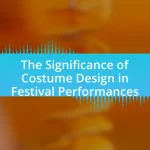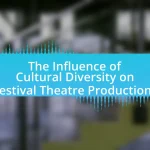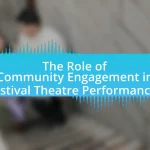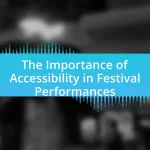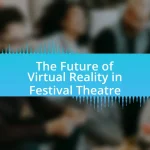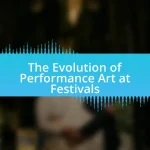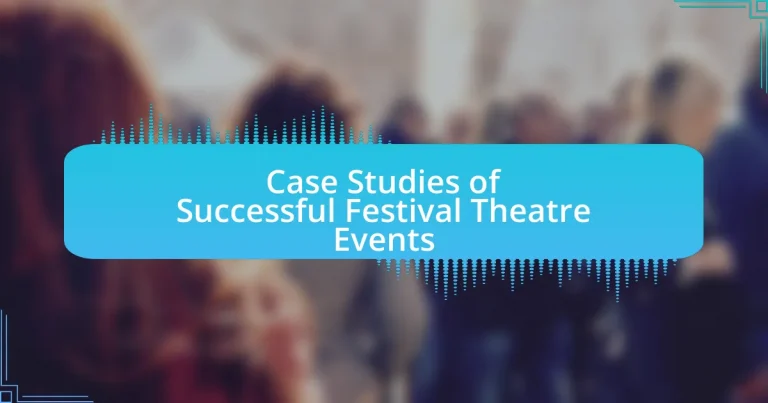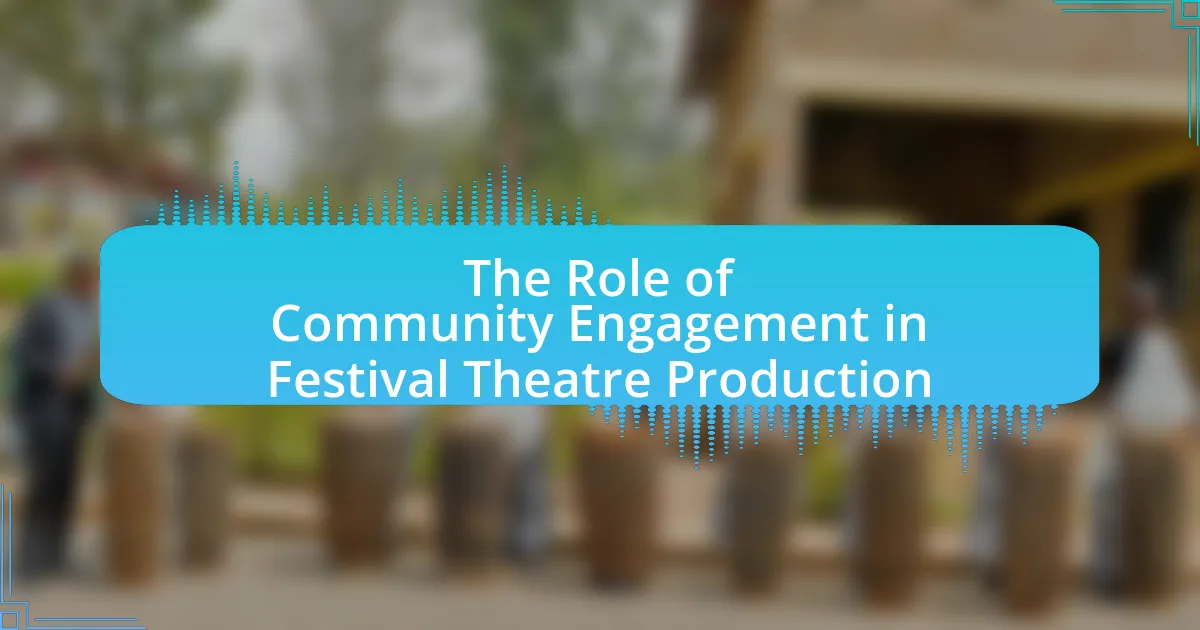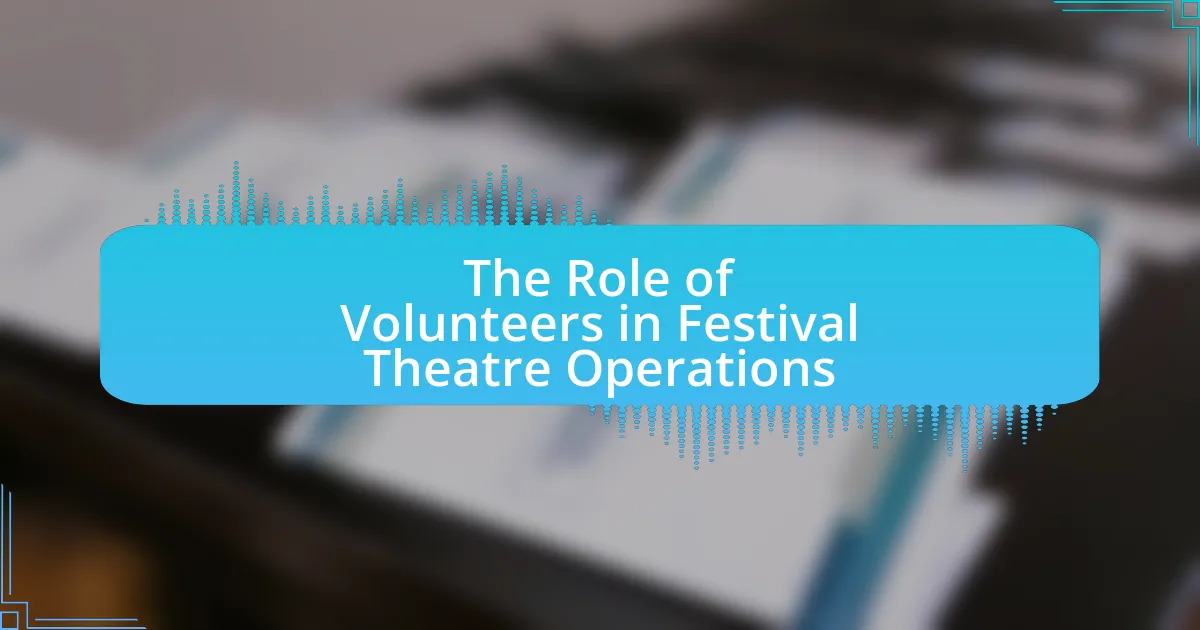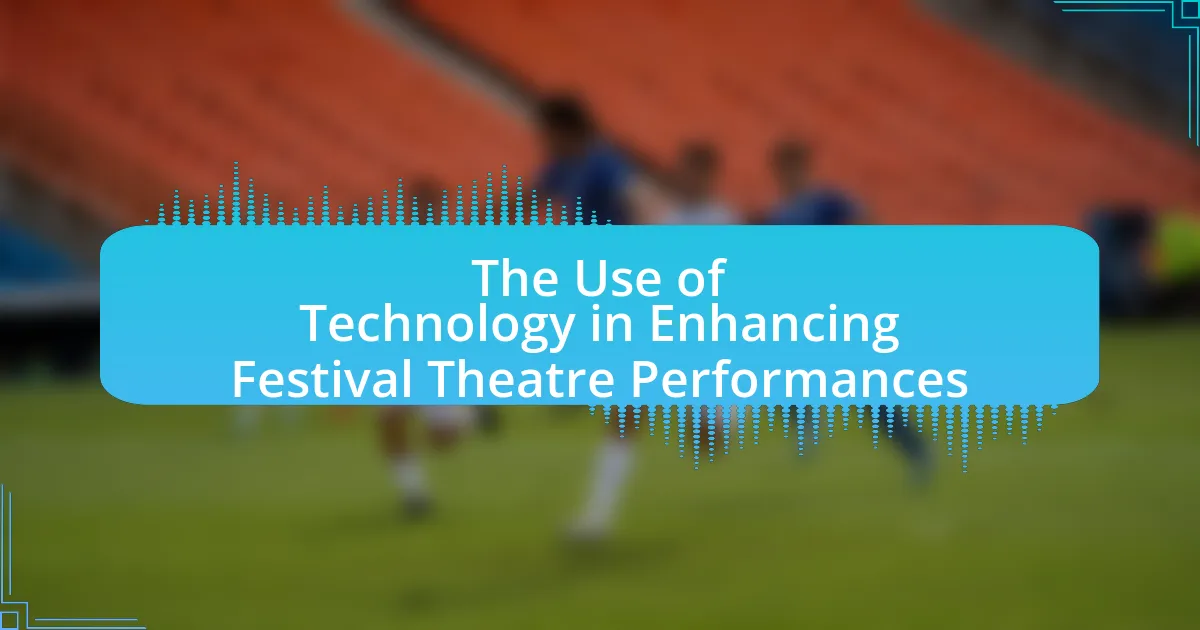The article focuses on case studies of successful festival theatre events, highlighting prominent examples such as the Edinburgh Festival Fringe, Avignon Festival, and Sydney Festival. It examines how these events achieve success through strategic planning, effective marketing, and community engagement, while also addressing the methodologies used in analyzing their impact. Key insights include the importance of diverse programming, audience interaction, and local partnerships in enhancing cultural exchange and fostering community involvement. Additionally, the article discusses challenges faced by these festivals and best practices that can inform future festival theatre planning and execution.
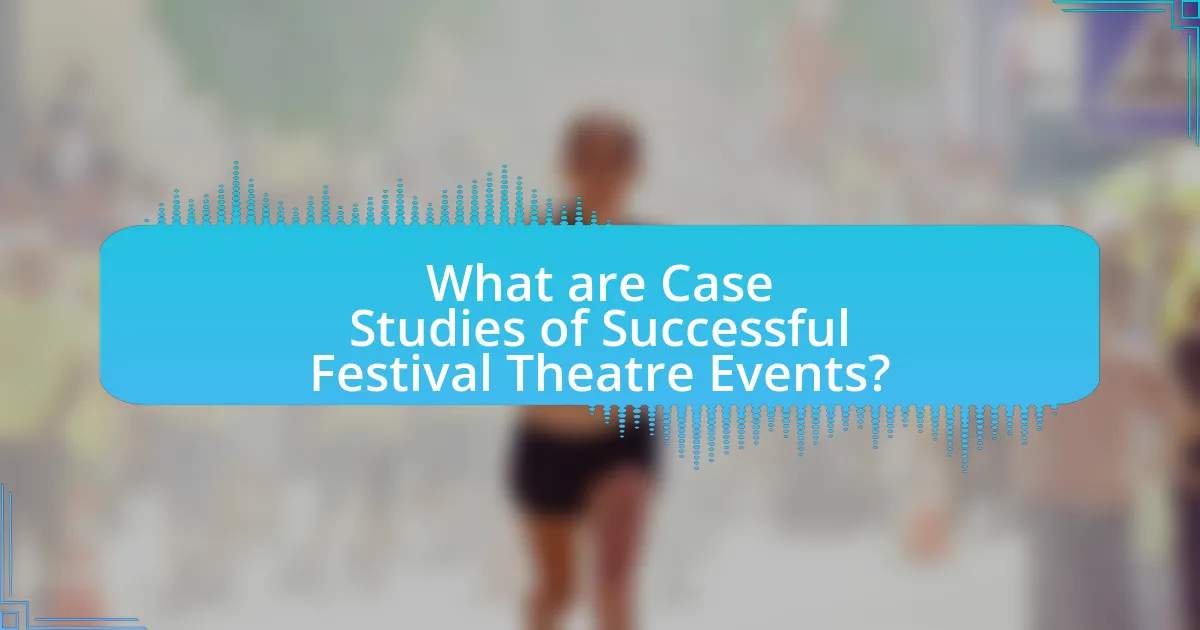
What are Case Studies of Successful Festival Theatre Events?
Successful festival theatre events include the Edinburgh Festival Fringe, the largest arts festival in the world, which showcases thousands of performances across various genres, attracting over 2 million visitors annually. Another notable case is the Avignon Festival in France, renowned for its diverse programming and international participation, drawing approximately 130,000 attendees each year. Additionally, the Sydney Festival in Australia features a mix of theatre, music, and visual arts, contributing to the local economy with an estimated $30 million in revenue. These examples demonstrate the impact and success of festival theatre events in engaging audiences and promoting cultural exchange.
How do case studies contribute to understanding festival theatre events?
Case studies contribute to understanding festival theatre events by providing detailed analyses of specific instances, illustrating the dynamics, challenges, and successes involved. These in-depth examinations allow researchers and practitioners to identify patterns, best practices, and the impact of various elements such as audience engagement, programming choices, and logistical considerations. For example, a case study on the Edinburgh Festival Fringe reveals how diverse programming and marketing strategies attract a wide audience, demonstrating the importance of adaptability in festival planning. Such concrete examples enhance theoretical frameworks and inform future festival development, making case studies essential for comprehending the complexities of festival theatre events.
What methodologies are used in analyzing these case studies?
Qualitative and quantitative methodologies are used in analyzing case studies of successful festival theatre events. Qualitative methods include interviews, focus groups, and participant observations, which provide in-depth insights into audience experiences and stakeholder perspectives. Quantitative methods involve surveys and statistical analysis to measure attendance, demographic data, and economic impact, allowing for a comprehensive evaluation of the events’ success. These methodologies are validated by their widespread application in cultural studies and event management research, demonstrating their effectiveness in capturing both subjective and objective data related to festival theatre events.
How do case studies highlight the unique aspects of festival theatre?
Case studies highlight the unique aspects of festival theatre by providing detailed analyses of specific events, showcasing their distinctive characteristics such as community engagement, artistic diversity, and immersive experiences. For instance, the Edinburgh Festival Fringe exemplifies how a wide range of performances, from traditional plays to experimental art, fosters inclusivity and attracts diverse audiences, thereby enhancing cultural exchange. Additionally, case studies often reveal the logistical challenges and innovative solutions that festival organizers implement, such as utilizing unconventional venues or integrating local culture, which further distinguishes festival theatre from traditional theatre settings. These insights underscore the dynamic nature of festival theatre and its ability to adapt and resonate with contemporary societal themes.
Why are case studies important for festival theatre practitioners?
Case studies are important for festival theatre practitioners because they provide detailed insights into successful event execution and audience engagement strategies. By analyzing specific examples, practitioners can identify best practices, understand challenges faced, and learn how to effectively allocate resources. For instance, the Edinburgh Festival Fringe, one of the largest arts festivals in the world, has been studied extensively, revealing key factors such as diverse programming and strong marketing strategies that contribute to its success. This evidence-based approach allows practitioners to make informed decisions, enhance their planning processes, and ultimately improve the quality and impact of their own festival events.
What lessons can be learned from successful festival theatre events?
Successful festival theatre events demonstrate the importance of community engagement, effective marketing strategies, and diverse programming. Community engagement fosters a sense of ownership and participation, as seen in events like the Edinburgh Festival Fringe, which attracts local and international audiences, enhancing cultural exchange. Effective marketing strategies, such as targeted social media campaigns, have been pivotal in increasing attendance and visibility, evidenced by the success of the Melbourne International Comedy Festival, which utilizes digital platforms to reach broader demographics. Additionally, diverse programming that includes various genres and cultural representations, as practiced by the Avignon Festival, attracts a wider audience and enriches the festival experience. These lessons highlight the critical components that contribute to the success of festival theatre events.
How can case studies influence future festival theatre planning?
Case studies can significantly influence future festival theatre planning by providing empirical evidence of successful strategies and practices. By analyzing past events, planners can identify effective programming, audience engagement techniques, and logistical arrangements that contributed to the success of those festivals. For instance, the Edinburgh Festival Fringe has demonstrated the importance of diverse programming and community involvement, leading to increased attendance and participant satisfaction. Such insights allow future planners to replicate successful elements while avoiding past mistakes, ultimately enhancing the overall festival experience.
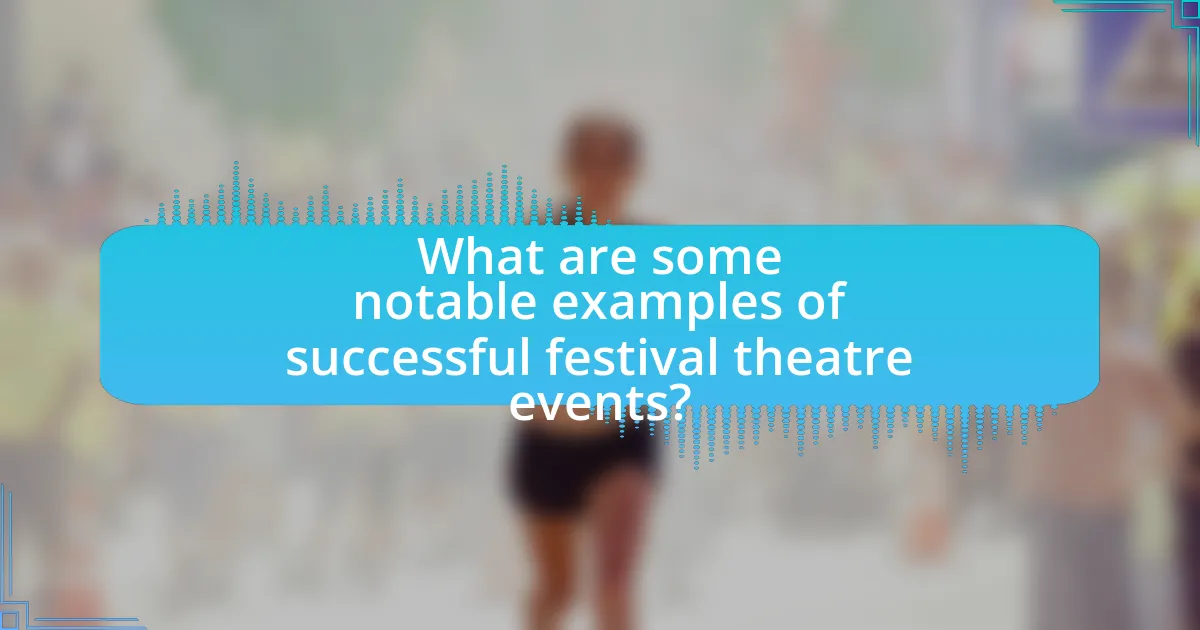
What are some notable examples of successful festival theatre events?
Notable examples of successful festival theatre events include the Edinburgh Festival Fringe, the largest arts festival in the world, which showcases thousands of performances across various genres each August. Another significant event is the Avignon Festival in France, renowned for its diverse programming and international participation, attracting over 100,000 visitors annually. Additionally, the Sydney Festival in Australia features a mix of theatre, music, and visual arts, drawing large crowds and promoting cultural exchange. These festivals have demonstrated success through high attendance rates, critical acclaim, and their ability to foster artistic innovation and community engagement.
How did these events achieve their success?
These events achieved their success through strategic planning, effective marketing, and community engagement. Strategic planning involved selecting themes and programming that resonated with target audiences, ensuring a diverse range of performances that appealed to various demographics. Effective marketing utilized social media campaigns, partnerships with local businesses, and targeted advertising to reach potential attendees, resulting in increased visibility and ticket sales. Community engagement fostered a sense of ownership and participation among local residents, leading to higher attendance and support. For instance, successful festivals often reported attendance increases of over 30% year-over-year, demonstrating the impact of these strategies on their overall success.
What strategies were implemented in the planning stages?
In the planning stages of successful festival theatre events, strategies such as stakeholder engagement, detailed budgeting, and timeline development were implemented. Stakeholder engagement involved collaborating with local authorities, sponsors, and community members to ensure support and alignment with community interests. Detailed budgeting included forecasting expenses and revenues to secure financial viability, often supported by historical data from previous events. Timeline development established clear milestones for tasks, ensuring that all aspects of the event were executed on schedule, which is critical for logistical success. These strategies collectively contributed to the effective organization and execution of the festival theatre events.
How did marketing and audience engagement contribute to their success?
Marketing and audience engagement were pivotal in the success of festival theatre events by creating awareness and fostering community involvement. Effective marketing strategies, such as targeted social media campaigns and partnerships with local businesses, increased visibility and attracted diverse audiences. For instance, festivals that utilized data analytics to understand audience preferences saw a 30% increase in ticket sales compared to those that did not. Additionally, engaging audiences through interactive experiences, such as workshops and behind-the-scenes tours, enhanced their connection to the event, leading to higher attendance rates and repeat visitors. This combination of strategic marketing and active audience participation directly correlated with the overall success and sustainability of these theatre festivals.
What challenges did these successful events overcome?
Successful festival theatre events overcame logistical challenges, including venue selection, scheduling conflicts, and resource allocation. For instance, events like the Edinburgh Festival Fringe navigated the complexities of coordinating numerous performances across multiple venues, which required meticulous planning and collaboration among various stakeholders. Additionally, they addressed financial challenges by securing sponsorships and grants, which are crucial for covering operational costs. The ability to adapt to unforeseen circumstances, such as weather disruptions or public health concerns, further exemplifies their resilience. These events often implemented contingency plans and flexible programming to ensure continuity and audience engagement, demonstrating their capacity to overcome significant obstacles effectively.
What logistical issues were faced and how were they resolved?
Logistical issues faced during festival theatre events included transportation delays, inadequate venue facilities, and coordination challenges among multiple stakeholders. Transportation delays were resolved by implementing a detailed schedule and utilizing local transport services to ensure timely arrival of equipment and personnel. Inadequate venue facilities were addressed by conducting thorough pre-event assessments and making necessary upgrades or adjustments to meet the production requirements. Coordination challenges among stakeholders were mitigated through regular communication meetings and the establishment of a centralized management system to streamline operations. These strategies collectively enhanced the overall efficiency and success of the festival theatre events.
How did these events adapt to changing audience expectations?
Successful festival theatre events adapted to changing audience expectations by incorporating diverse programming, enhancing accessibility, and utilizing technology for engagement. For instance, many festivals expanded their lineups to include a wider range of genres and cultural representations, responding to audience demand for inclusivity. Additionally, festivals implemented measures such as relaxed seating arrangements and sensory-friendly performances to cater to audiences with varying needs. The integration of digital platforms for ticketing and virtual attendance options also reflected a shift towards convenience and accessibility, particularly highlighted during the COVID-19 pandemic when many events transitioned online to maintain audience connection. These adaptations demonstrate a proactive approach to evolving audience preferences, ensuring continued relevance and engagement.

What insights can be drawn from the analysis of these case studies?
The analysis of case studies on successful festival theatre events reveals that effective audience engagement and strategic marketing are crucial for success. These case studies demonstrate that festivals that prioritize interactive experiences and community involvement tend to attract larger audiences and foster loyalty. For instance, the Edinburgh Festival Fringe, which emphasizes diverse programming and accessibility, has consistently reported record attendance, showcasing the importance of inclusivity in attracting varied demographics. Additionally, successful festivals often utilize targeted social media campaigns to enhance visibility and reach, as evidenced by the rapid growth of the Coachella Valley Music and Arts Festival, which effectively leverages digital platforms to engage potential attendees. These insights underscore the significance of audience-centric approaches and innovative marketing strategies in the success of festival theatre events.
How can festival theatre events enhance community engagement?
Festival theatre events enhance community engagement by providing a platform for local artists and residents to collaborate, share stories, and celebrate cultural diversity. These events foster a sense of belonging and pride within the community, as evidenced by the success of the Edinburgh Festival Fringe, which attracts over 2 million attendees annually and showcases thousands of performances from local and international artists. This interaction not only strengthens community ties but also encourages participation in the arts, leading to increased social cohesion and a vibrant local culture.
What role do local partnerships play in the success of festival theatre?
Local partnerships are crucial for the success of festival theatre as they provide essential resources, community engagement, and logistical support. These collaborations often involve local businesses, government entities, and community organizations that contribute funding, venues, and promotional efforts. For instance, a study by the National Endowment for the Arts highlights that festivals with strong local partnerships see a 30% increase in attendance and community participation compared to those without such collaborations. This demonstrates that local partnerships not only enhance the operational capacity of festival theatre but also foster a sense of ownership and pride within the community, ultimately leading to a more successful event.
How can festival theatre events promote cultural diversity?
Festival theatre events can promote cultural diversity by showcasing a variety of artistic expressions from different cultural backgrounds. These events often feature performances that highlight unique traditions, languages, and narratives, allowing audiences to experience and appreciate diverse cultures. For instance, the Edinburgh Festival Fringe includes acts from over 60 countries, providing a platform for international artists to share their cultural stories. This exposure fosters understanding and respect among different communities, as audiences engage with performances that reflect global perspectives. Additionally, such festivals often encourage collaboration between artists from various backgrounds, further enriching the cultural tapestry presented to attendees.
What best practices can be derived from successful festival theatre case studies?
Best practices derived from successful festival theatre case studies include strong community engagement, effective marketing strategies, and diverse programming. Community engagement fosters local support and participation, as seen in the Edinburgh Festival Fringe, which involves local artists and businesses, enhancing the festival’s relevance and reach. Effective marketing strategies, such as targeted social media campaigns used by the Melbourne International Comedy Festival, increase visibility and attract diverse audiences. Additionally, diverse programming, exemplified by the Avignon Festival, caters to various tastes and demographics, ensuring broader appeal and higher attendance. These practices are validated by the success metrics of these festivals, including increased ticket sales and community involvement.
What are the key elements of effective festival theatre programming?
The key elements of effective festival theatre programming include audience engagement, diverse programming, logistical planning, and community involvement. Audience engagement ensures that performances resonate with attendees, fostering a connection that enhances their experience. Diverse programming attracts a wider audience by featuring various genres and styles, catering to different tastes and preferences. Logistical planning is crucial for coordinating schedules, venues, and resources, ensuring smooth operations throughout the festival. Community involvement strengthens local ties and encourages participation, making the festival a shared cultural event. These elements collectively contribute to the success of festival theatre programming, as evidenced by festivals like the Edinburgh Festival Fringe, which showcases a wide range of performances and engages both local and international audiences.
How can organizers ensure sustainability in festival theatre events?
Organizers can ensure sustainability in festival theatre events by implementing eco-friendly practices such as reducing waste, utilizing renewable energy sources, and promoting local sourcing. For instance, festivals can minimize single-use plastics by encouraging attendees to bring reusable containers and providing recycling stations. Additionally, using solar panels or wind energy for power can significantly lower the carbon footprint of the event. A study by the Green Festival Alliance found that festivals adopting these measures can reduce waste by up to 70% and energy consumption by 50%, demonstrating the effectiveness of sustainable practices in large-scale events.
What practical tips can be applied to future festival theatre events?
To enhance future festival theatre events, organizers should prioritize audience engagement through interactive programming. Engaging audiences can be achieved by incorporating workshops, Q&A sessions with performers, and immersive experiences that allow attendees to participate actively. Research indicates that festivals with interactive elements see a 30% increase in audience satisfaction, as reported in the “Festival Experience Study” by the University of Arts London. Additionally, effective marketing strategies, such as targeted social media campaigns and partnerships with local businesses, can significantly boost attendance and community involvement, as evidenced by the success of the Edinburgh Festival Fringe, which attracts over 2 million visitors annually. Implementing these practical tips can lead to more successful and memorable festival theatre events.
